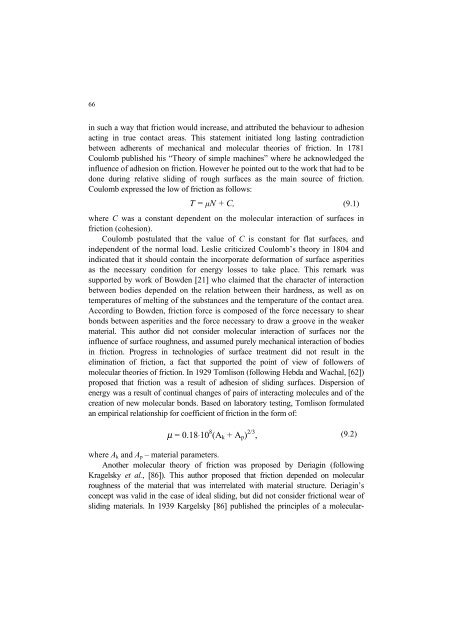Strona 2_redak - Instytut Agrofizyki im. Bohdana DobrzaÅskiego ...
Strona 2_redak - Instytut Agrofizyki im. Bohdana DobrzaÅskiego ...
Strona 2_redak - Instytut Agrofizyki im. Bohdana DobrzaÅskiego ...
Create successful ePaper yourself
Turn your PDF publications into a flip-book with our unique Google optimized e-Paper software.
66<br />
in such a way that friction would increase, and attributed the behaviour to adhesion<br />
acting in true contact areas. This statement initiated long lasting contradiction<br />
between adherents of mechanical and molecular theories of friction. In 1781<br />
Coulomb published his “Theory of s<strong>im</strong>ple machines” where he acknowledged the<br />
influence of adhesion on friction. However he pointed out to the work that had to be<br />
done during relative sliding of rough surfaces as the main source of friction.<br />
Coulomb expressed the low of friction as follows:<br />
T = N + C, (9.1)<br />
where C was a constant dependent on the molecular interaction of surfaces in<br />
friction (cohesion).<br />
Coulomb postulated that the value of C is constant for flat surfaces, and<br />
independent of the normal load. Leslie criticized Coulomb’s theory in 1804 and<br />
indicated that it should contain the incorporate deformation of surface asperities<br />
as the necessary condition for energy losses to take place. This remark was<br />
supported by work of Bowden [21] who cla<strong>im</strong>ed that the character of interaction<br />
between bodies depended on the relation between their hardness, as well as on<br />
temperatures of melting of the substances and the temperature of the contact area.<br />
According to Bowden, friction force is composed of the force necessary to shear<br />
bonds between asperities and the force necessary to draw a groove in the weaker<br />
material. This author did not consider molecular interaction of surfaces nor the<br />
influence of surface roughness, and assumed purely mechanical interaction of bodies<br />
in friction. Progress in technologies of surface treatment did not result in the<br />
el<strong>im</strong>ination of friction, a fact that supported the point of view of followers of<br />
molecular theories of friction. In 1929 Tomlison (following Hebda and Wachal, [62])<br />
proposed that friction was a result of adhesion of sliding surfaces. Dispersion of<br />
energy was a result of continual changes of pairs of interacting molecules and of the<br />
creation of new molecular bonds. Based on laboratory testing, Tomlison formulated<br />
an empirical relationship for coefficient of friction in the form of:<br />
µ = 0.18⋅10 8 (A k + A p ) 2/3 , (9.2)<br />
where A k and A p – material parameters.<br />
Another molecular theory of friction was proposed by Deriagin (following<br />
Kragelsky et al., [86]). This author proposed that friction depended on molecular<br />
roughness of the material that was interrelated with material structure. Deriagin’s<br />
concept was valid in the case of ideal sliding, but did not consider frictional wear of<br />
sliding materials. In 1939 Kargelsky [86] published the principles of a molecular-
















